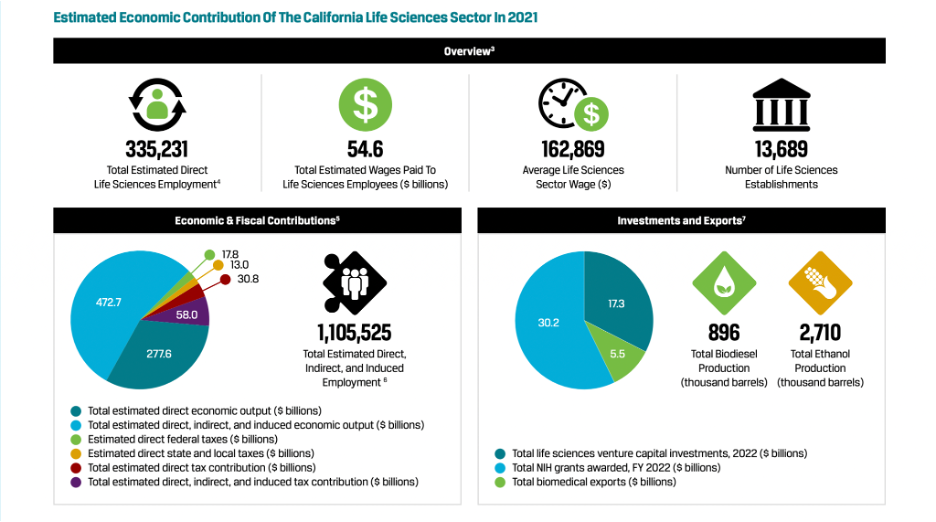The number of life sciences establishments in California grew 6% from 2020-2021, finds a recent report from California Life Sciences (CLS).
That’s just one of the striking statistics about the sizable growth of California’s life sciences sector covered by the report.
“California’s life sciences sector leads the nation in R&D investment and labor, delivering innovation and therapies that have a life-changing impact on patients,” says CLS President and CEO Mike Guerra. “This report demonstrates our sector’s outsized impact on the national and global economy.”
Here are a few key findings.
Dramatic growth for California’s life sciences sector

From 2019 to 2022, California life sciences demonstrated swift growth, yielding direct favorable results at both the state and national levels.
The California life sciences sector has not only gained physical traction but financial traction, as well. The National Institutes of Health (NIH) and National Science Foundation (NSF) awarded the state with a collective $5.59 billion in grants.
In addition, venture capital investments increased by 50% over a three-year span. Furthermore, California’s life sciences sector produced over $450 billion in economic output in 2021, with an additional estimated $50 billion in tax revenues.
These economic increases led to an exuberant rise in employment rates in the sector. According to the report, the life sciences “directly employed 335,231 people in 2021, and indirectly supported 1,105,525 jobs.”
R&D in California

In 2021, investments in research and development (R&D) amounted to $7.1 billion. This constitutes approximately 14% of all R&D expenditures in the U.S. life sciences sector nationwide. From 2017 to 2021, California saw a 25% uptick in R&D investments. This surge surpassed the national growth rate by 3.5%.
And companies effectively utilized research funding from the NIH and NSF.
In 2022, California life sciences institutions secured a substantial $5.5 billion in NIH funding and $97.3 million from the NSF. These figures not only place California at the forefront of life sciences innovation but also solidify the state’s top ranking in terms of both the number of awards and the award amounts for both NIH and NSF grants.
NIH grants are pivotal in advancing research in the biotechnology and health sectors. Large grants like these kick off immediate and long-term advancements. A study conducted by United for Medical Research revealed that for every $1 million in NIH funding to California institutions, 14 jobs were generated within the state.
Regarding NSF awards, California accounted for a striking 13% of all awards granted in 2022. This achievement is significant as it is twice the number of awards received by the second-most-awarded state, New York.
The impact on patents, higher education
The patent environment highlights positive outcomes of R&D funding. In 2020, California achieved the #1 position in terms of patents granted per 1,000 individuals. In fact, California’s patent rate per person (45.3) is twice the national average of 22.4.
Furthermore, an impressive surge of almost 10% has been observed in the issuance of patents to companies rooted in California. This escalation saw the number of patents rise from 1,360 in 2016 to 1,495 by the year 2021.
Besides the economic contributions, the life science sector is also boosting higher education. California is home to the highest number of World Top 100 universities, as well as the largest number of life science undergraduates and doctoral graduates (11.5%).
What are the life sciences?
The life sciences sector encompasses enterprises engaged in pharmaceuticals, biotechnology, medical devices, biomedical technologies, nutraceuticals, cosmeceuticals, food processing, and related areas. These companies are committed to developing products aimed at enhancing the well-being of living organisms.
According to the July report, the California sector primarily focuses on research, testing, medical laboratories, and bioscience.
To learn more: CLS will host a town hall about the report on August 23, 2023. Speakers include CLS President Mike Guerra, SVP of Racial and Social Equity & Culture Marc Fields, and SVP of Government Relations & External Affairs Brent Fisk. They will explore the findings and what keeps California a viable leader in driving innovation, advancing therapies, and improving health outcomes. Click here to register.




